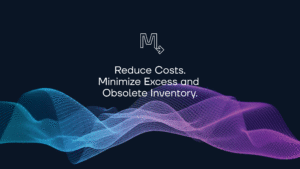Five (5) Important Considerations When Upgrading Your Sales Enablement Tools
Driving sales force effectiveness, accurate forecasting, and serving your surgeons better are some of the things you know you must do.
Is a semi-custom CRM tool alone good enough anymore? (or anything built in-house these days?)
Managing opportunities is important, but you know that barely scratches the surface. Reps need to actually take care of the surgeon. Sales reps perform so many operationally focused tasks, that communication at every level is needed.
When armed with the technology to be able to best serve the surgeons (managing preferences, quick response time, accurate fulfillment) reps can distinguish themselves as a reliable choice.
Creating a reputation of demonstrable trustworthiness, and having the capacity to foster relationships is a far more effective sales tool than trying to “manage” people into a professional relationship.
The value and opportunity for a better sales tool are apparent, but what would a better sales tool look like? Before jumping on board with a generic CRM tool, or trying to “build it out” into your existing CRM, consider these areas:
1. User Adoption
Trick Question: Which sales enablement tool is the best?
Answer: It’s the one that gets used.
It doesn’t matter how good it appears, if it doesn’t encourage user adoption, it doesn’t matter. If it doesn’t get used, it isn’t working.
A decade of CRM implementation studies reveals that substantial numbers of customers are dissatisfied, experiencing up to 70% failure rate (prevented from “going live”). From our extensive experience, the rate is even higher within the medical device industry. This is a serious problem.
An analysis of over 300 businesses that ditched their CRM indicated that the most common reason was their employees just weren’t using the system. Another source working with over 1,000 organizations determined that the average CRM adoption rate for a field sales team is around 35%. More than four in five senior execs implementing sales enablement tools agree that their biggest challenge is getting the team to actually use the software.
The main reason typical systems don’t get used in the medical device space is that they were not purpose-built for the medical device space, and if they were, they were built in-house with outdated technology and unfriendly user experiences. Other common reasons for CRM failure include high cost, excessive complexity, and frustration with customer support.
Understanding User Adoption
Adoption rates can be tricky to determine. Login rates don’t reveal much because reps may log in intermittently to meet compliance, but they may not want to – or even know how to – use all the functions and features available to them.
Even reps who log in regularly often only take advantage of about half the functionality available.
A more accurate picture of adoption addresses the percentage of actions that are supposed to be completed using the software tool which are in fact being accomplished within the software tool. This is a metric that must be measured.
Many major in-house and major CRM tools lack the ability to drive adoption and to capture important data because they do not have visibility to the entire field sales process (scheduling, requesting, consignment, loaners, usage capture, billing, replenishment, pricing, HIPAA compliance communication).
If the tool unifies all the field operations and is integrated into your back-end operations, it can intelligently record all actions, even when a user performs it outside the system. The resulting data can then be used to—among other things—identify and rectify operational gaps (inventory transfers etc.).
The Sales Rep has one primary mission: serve their surgeons better.
Any rep will use the best means available to accomplish that objective—even if that means going outside the system.
The key is to have a sales tool that helps reps do their job better, and make sure it is easier to use than methods outside the system. When the tool is intuitive to the Sales Rep, it doesn’t take weeks or even days to master: they can get up and running within minutes.
2. Modern Technology
Simply offering any solution 15 years ago was a win and then offering a cloud-based SaaS system was exciting 5 years ago, but it’s not enough anymore.
Sales Force Effectiveness Secret: experience drives behavior.
Interface expectations have changed drastically. With a myriad of apps facilitating every aspect of our lives, user experience has advanced and evolved to become a vital component to productivity. To realistically expect a sales rep to want to use an enterprise tool, it should be designed and updated to meet the usability expectations of today.
The whole concept of CRM—originally operating on the premise that people can be managed (manipulated?) through regular contact—was conceived for a domain that was relatively naive about the medical device industry.
Value in the current business environment has shifted to focusing technology on producing more desirable outcomes while improving the ease of doing business. What that means is that the sales relationships and sales networks excel when the rep is able to offer a superior, more reliable customer experience.
Since sales reps spend on average 65% of their time performing non-selling functions in the medical device space, when enabled with a more efficient and powerful tool, a rep will have more time and energy to invest into surgeon relationships. This gain is because the rep will not be bogged down in administrative duties or inventory management duties because of clunky, outdated tools and processes.
3. Usability
A CRM may try to jazz-up their interface or add basic customization. But when it’s too rudimentary to handle any robust functionality, it adds unnecessary complexity. This is why many users, when given a chance, choose to revert to older UI versions. The attempted UI upgrade offers little improvement to user friendliness.
More is not better. 72% of CRM customers prefer “ease of use” over more functions.
The ideal sales tool interface would be designed with specific duties by role (and the med device industry as a whole) in mind. It needs to be clean, modern, and efficient: something reps enjoy using. The functionality should be powerful, intuitive, and allow reps to work effectively; spending more time selling, and less time doing other non-selling duties.
4. Purpose-Built Mobile App
General-purpose won’t cut it. Your customers are not generic, they have specific needs. To properly care for them, your sales and inventory field automation tool needs to be integrated into with the tool that manages their business specifically.
An increasing trend is attempting to use a CRM as a system of record, but this has a high chance of failure: 42 percent of organizations who tried, couldn’t do it. Their users were consistently recording information in other tech tools (or physical means) instead. Yes, this is an adoption issue, but the root problem stems from attempting to force intricate, industry-specific processes into a tool that was never designed to handle them.
On the other hand, frustrations with customer support (another major reason CRM implementations fail or are abandoned) betrays not only the CRM company’s inability to provide meaningful attention to their clients, but the deeper issue there is an overly-complex user interface and tool set. The fact that there is a market for third (or fourth)-party companies to step in and facilitate in-app user training should be a clue that your CRM is introducing unnecessary complexities.
The medical device industry has a world of unique complexities.
A good sales tool deals with complexities behind the scenes, through automation.
That’s impossible to do unless the back-end is designed for your industry, customized for your business, and connected intimately with the systems where most of your work is done.
Using specially developed native mobile apps can offer much more value than just “mobile-friendly” websites, including offline capabilities and better app performance.
Mobile business apps can increase efficiency, productivity, and customer satisfaction by at least 74%.
5. Initial Price vs. Total Cost
Are reps maximizing ROI in this tool?
Determining which technology solution best supports your business needs is a tough enough nut to crack. Beyond that, add having to consider how various pricing models stack up against each other, and then having to provide economic justification while navigating budget or approval processes. This all adds further levels of complexity to the decision-making process.
But “Price” is often misleading. More critical to implementing a solution long-term is the actual “True Cost” to operate the software (price + ancillary costs).
Looking at just the ongoing user fees, you might be paying 3-4 times more than the offered value, because with a 25% adoption rate (and that is commonly found in this industry), 75% of what you are paying for goes unused—it is just wasted.
Then there may be higher fee tiers if you want features such as access to your data for reporting.
A leading reason organizations implement a sales tool is in order to reduce waste (of resources such as time, money and inventory). Yet ironically, it’s estimated that companies have wasted overall $1 billion on software that they aren’t using.
This suggests that the features are either not needed, or they are too overly complex to use, or the tool doesn’t actually make the rep’s life easier (hence it never gets adopted).
That’s just addressing the price of admission.
A better picture of ‘True Cost’ factors in any other costs associated with doing business using a particular partner.
Typically these ancillary expenses cost organizations millions of dollars annually:
- write-offs for lost inventory
- overtime and outsourcing for audits and reconciliation
- time wasted by reps and sales ops on non-sales duties
- operational issues that resulted in lost surgeons
- lack of growth-enabling insight due to little or no data
- Third-party training consultants to promote adoption (by manipulating external factors)
So an ideal sales tool should curb those costs, providing value that negates “Price” by offering:
- High User Adoption:
- An easy-to-use interface which reps enjoy using
- Powerful functionality in one tool: Audits, communication, schedule, inventory, and more
- Intelligent Automation:
- Increase sales opportunities by reducing busywork
- Improve surgeon retention & satisfaction with reliable communications with ops
- All Inclusive Value:
- Training and support included
- Unlimited Data access and reporting included
When considering “true cost,” a tool that includes the above is an investment with substantive ROI through reduction in wasted resources and opportunity for intelligent growth.
When you truly enable the field sales team, everyone gets what they want.
If you want to optimize your field sales operations and inventory, remember to focus on:
- User Adoption
- Technology
- Integrations / Usability
- Design (functionality & connectivity)
- True ROI
Often, what we do at Movemedical is help you look into your current systems and help you find the gaps so you can create the best path forward for your organization.
If getting some expert outside eyes on the issue sounds reasonable, give us a call.
The best solutions help you get the job done, right.
Movemedical offers all this and more.
Your world is complex. Movemedical can help make it simple.
Intelligent Field Automation…by design.
ready to take your next step? email: mm@movemedical.com
Don’t worry. There are people who understand. People that have been in your shoes. Also, there are tools that can help.
Keep pushing. You are needed.
Good luck!
P.S. –
If you want to sell more, build stronger relationships all while reducing headaches and cumbersome manual admin work, you need to speak with us.
Contact us: 858.956.0219 or info@movemedical.com
WATCH DEMO NOW (you can personalize it to your needs/wants)
A good sales & inventory solution is worth its weight in gold, a fully integrated medical device specific operations and sales force effectiveness platform is priceless.
A complete sales & inventory tool should be able to or have:
- Surgery Scheduling (+ Calendar)
- Surgeon Preferences / Preference Cards
- CRM / Case & Opportunity Management
- Inventory Control & Visibility (All Locations, All Buckets)
- Active Order Visibility
- Opportunity/Lead Management
- Customer/Account Management
- Sales Metrics / Data (Reps, Leaders, Corporate)
- Shipping Coordination (FedEx, UPS Integration)
- Directed Picking & Put-away (Bin Mapped)
- Auto Product Replenishment
- Commission Calculations
- Expiration Notifications
- Direct Orders
- Send & Receive Tools (Rep to Rep etc.)
- Contract & List Pricing (Real-time)
- Audit/Cycle Counts
- Reporting & Billing
- Image & File Sharing
- Secure HIPAA Compliant Communication
- Mobile Usage Capture
- UDI Compliance
- Barcode Scanning
- RFID Integration & RFID Reconciling (HF/UHF)
- ERP/CRM/EMR Integrations
- Demand Planning Tools
- Consignment/Loaner Management
- Pluggable Workflows (Programmatic Integrations, Integrated Prediction Models)
- Sourcing Matrix Tool
- HIPAA Compliant Communication Platform (Messages, Calendar, Usage, Notes, Files)
- Sourcing Optimization
- Future Stock (Virtual Inventory Assigned to Future Events)
- Atomic Inventory (UDI Ready, Piece Level Tracking, Serialized or Not)
- Hybrid Kitting (Skinny Kits, Kit Management, Kit Versioning, Tracking)
- Cross Boundary Workflows
- Lost & Found (Automatic Cycle Counting )
- Merger/Acquisition Integration
- Par Management
- Multi-Catalog Management
- Loan Optimization (1 Loan Per Day)
- Separate or Combined Sales & Operations Alignment
- Cost-to-Serve Metrics
- Turn Ratio Dashboards
Need to talk with someone? We understand. Call anytime.
phone: 858.956.0208
email: mm@movemedical.com
or visit: www.movemedical.com/product



